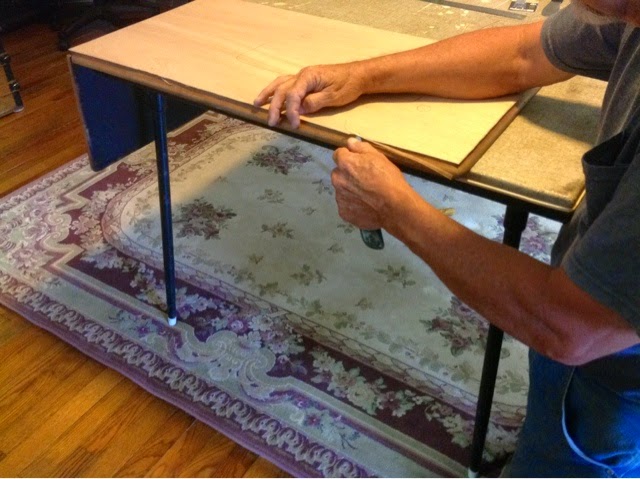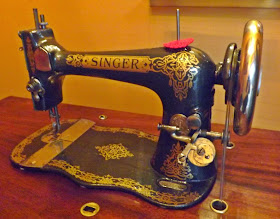The last post covered applying new veneer, but before that could happen I had to remove the brass fittings in the cabinet top, and the wooden spindle (?) that holds the machine in place when you tip it back,
The brass bits were dirty, corroded, and sometimes full of detritus.
 |
| Treadle Belt hole |
Two tabs on the back of the bonnet cover slide into the two corresponding slotted domes on the cabinet top.
The thing that holds the hinged pin that secures the machine head to the cabinet was surrounded by a rubber gasket. It was a mess to remove, and I wondered how I would replace it. But the attachment hinge itself was broken, so in the end it did not matter.
A few of the brass bits were missing, and I found a bag of VS2 brass fittings on eBay. So now I have some extras for another project. There is ALWAYS another project in the future.
By the way, a wire brush on the Dremel tool cleans all the gunk and corrosion off of metal parts brilliantly. I also used it on the metal sewing machine parts like the bobbin winder, the needle holder, the slide plates, etc.
The key to using the Dremel is to let the speed do all of the work, just apply it lightly and DO NOT USE FORCE. I know this. I remind myself of it every time I get the tool out. And eventually I get all absorbed in the project and bear down.
If you are using a wire brush when you bear down, guess what happens? The little wires break away and fly off. If you are wearing a cashmere sweater, as I do every day in the winter, the little wires embed themselves in the cashmere.
Just in case you doubt that I wear cashmere every day, even when working on sewing machines, let me reveal my secret. I buy all of my cashmere sweaters at thrift stores, where all the sweaters are the same price, around $3 to $4. I have five of them now collected over a couple of years. The men's sweaters are usually a thicker cashmere than the women's. And a man's XL, with the sleeves rolled up, fits my magnificent figure very well.
So a couple of hours of this project involved picking tiny wires out of a cashmere sweater. If it hadn't been cashmere I would have just thrown it away. I also scrupulously cleaned the area, not my favorite thing to do. But I shudder to think of those tiny wires embedded in the tiny paws of my tiny elderly dog. A couple of them embedded themselves in my own paws, not fun at all.
I bought a bunch of relatively cheap wire brushes online, but I know from sad experience that the brand name ones fly apart when abused also. Another tip if you buy the cheap ones: run a bead of super glue around the base of the brush where the wire tendrils attach. I do think it helps, but it does not prevent user-stupidity.
I finished the metal polishing by setting up a work station surrounded by a large cardboard box, and wore a bright yellow lineman's raincoat over my cashmere sweater. And here's yet another tip: If you need a raincoat that is truly WATERPROOF and not just WATER RESISTANT, lot of luck if you are shopping women's fashions. Go to your local hardware store and look for the raincoats that outdoor workers wear. I think I paid $10 for mine, but that was a couple of decades ago. I could have gotten matching pants too. Wouldn't that be fashionable?
I persuaded the newly polished brass bits back into position. Some of them needed more persuasion than others, and I used a scrap piece of wood on top of the brass and then tapped that wood piece with a small hammer.
 | |
| look at the lovely gleam on all the polished metal parts |
In the "before" photos you can see that the finish looks very dark. In real life it looked almost black, and the surface was rough. The old finish had both decayed and absorbed considerable dirt over the last 100 years. Much (but not all) of it had to go.
All of the myriad decisions about what to do with these old machines are influenced by personal preferences--both my own, and the owners. Sadie and Patricia wanted it to be pretty. I don't like machines that have had all of the character sanded off. Plus I don't really trust myself with sandpaper. Obviously the cracked and peeled and just generally ruined top had to be replaced with new veneer. But on the rest of the cabinet and bonnet I used denatured alcohol to remove a great deal of the old finish.
The bonnet was black with age and had fallen apart. I glued and clamped it and let the glue dry overnight. I sloshed some denatured alcohol on with a soft cloth, let it sit for a bit and scrubbed it off with 0000 steel wool. I used a toothbrush to get into the nooks and crannies. I repeated this process until it looked like mahogany rather than black dirt.
 |
| original drawer, black with age and dirt, corroded drawer pull |
 |
| Can you spot the differences in the drawer finish or handles? Neither can I. |
Here's a warning, though, if you are searching eBay or any other site for a replacement Singer drawer. Not all Singer drawers are created equal, and it is not just the difference in the wood. I have several spare drawers here, but did any of them fit? Of course not. The dimensions were different.
I used the alcohol + steel wool process on the entire cabinet and original drawer. Then I went over everything with Howard's Restor-a-Finish in mahogany, just to even out the color. I did all of this before we replaced the veneer because I did not want any stray dirt, stain, or chemicals to contaminate the nice new veneer.
And at this point I owe you all a huge apology. I began this project with the firm intent of documenting and photographing every aspect of the restoration. Then December happened and I decided that I had a good chance of finishing it and getting it back to Sadie and Patricia before Christmas. And I completely forgot about the photos. We did take a few as we delivered it.
But there are no pictures of staining process. I dithered about doing this for a couple of months after Dexter applied the veneer (see last post). I was terrified. I had tried using stain before to even out the color on old beat up pieces, and wasn't too thrilled with the results.
It turned out to be very easy and worked beautifully. I only stained the new veneer. Lightly sanded it with 220 grit, then wiped it down with mineral spirits and then a tack cloth. Tested three different colors of stain on scrap pieces of the veneer. "Red mahogany" was the right color.
 |
| You can see the naked un-stained veneer at the top of the photo |
Tests on the scrap piece showed that two coats were better than one, but I saw no difference between two coats and three. I followed the directions on the can. Painted it on with a disposable sponge brush, let it sit for 15 minutes, wiped it off. Let it dry 24 hours and then repeated.
I followed up the stain with tung oil, which is my favorite finish BECAUSE it is super easy and I really know almost nothing about furniture refinishing. Wipe it on, wait a bit, wipe off the excess, wait 24 hours and do it again. All the experts say to sand in between coats. Did not work for me and I will never do it again! I ended up sanding right down through the stain which meant that I had to restain that part and then put more tung oil on it. Like I said, I'm not very good at this.
It does need SOMETHING to smooth out the surface. So if the sanding does not work, what does? 0000 steel wool (pronounced Four Ought).
 |
| Pull a scrap off one of the wedges in the pack |
The final step was a coat of Howard's Feed N Wax, which I also recommended to Sadie and Patricia as the maintenance product for the cabinet. It produces a lovely luster.
 |
| I am not advertising or promoting any of these products, just sharing what I used and giving you my unpaid opinions about them |
So, folks, that's how I did it. I do not claim it is the RIGHT way to do it. But it worked for me.
And the same pictures that you have already seen, again. Because they are SO worth looking at. But really because I just did not take enough pictures.
 |
| The angles of the photo creates different shades of color but if you compare the top of the bonnet with the newly veneered cabinet top you will see that the color match is flawless. |
 | |
Next post: Paint and decals, and I DID take pictures of that! See you soonish.




















































